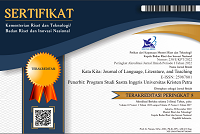The Lost of Virtual and Simulated Identity in Online/Virtual Platform Written Adaptation of a Game “Digimon Story Cyber Sleuth: Hacker’s Memory”
(1) Petra Christian University, Jl. Siwalankerto No.121-131, Siwalankerto, Wonocolo, Surabaya
(2) Petra Christian University, Jl. Siwalankerto No.121-131, Siwalankerto, Wonocolo, Surabaya
(*) Corresponding Author
Abstract
This creative project is a written adaptation of a video game entitled Digimon story Cyber Sleuth: Hacker’s Memory (2017). This adaptation will retell a story from the aforementioned video game title about an alternate Japanese society where technology has evolved so much that people can dive into a cyber space called EDEN. By using a set of computers and a special device called Digivice. In this virtual cyberspace, a physical manifestation can be achieved by having a virtual account and many people at the beginning of the story have been using EDEN for years to do many things. The story begins with a young man who lost his virtual account. In order to get his account back he has to get involved in the world of hackers which are individuals who are able to temper the programming codes of EDEN just like how it used to be in regular computers to achieve a certain purpose. In this involvement the protagonist also encounters creatures known as Digimon which will then play a major role in the story moving forward. The protagonist also meets a hacker group called Hudie which the protagonist ends up joining in order to gain support in searching for his missing account. The theme of this adaptation is how a missing a virtual identity ends up shaping another identity for the main protagonist. This adaptation also serves as a journey for the main protagonist who at the beginning falls under the category of “hacker” which is a bad term into a “hero” at the end.
Key words: Virtual, cyber space, hacker, mental data, avatar, account, identity.
Full Text:
PDFReferences
Baudrillard, J., & Poster, M. (1988). Selected writings. Stanford, CA: Stanford University Press.
Baudrillard Short Introduction. (n.d.). Retrieved September 28, 2016, from http://publish.uwo.ca/~dmann/baudrillard1.htm
Christopher R J. Mckinley, Dana Mastro, Katie M. Warber. (2014). Social Identity Theory as a Framework for Understanding the Effects of Exposure to Positive Media Images of Self and Other on Intergroup Outcomes. International Journal of Communication 8 .
Deheer, Laura. (2015) Everything You Need To Know About Shonen Jump
https://goodereader.com/blog/manga-and-anime-news/everything-you-need-to-know-about-shonen-jump
Digimon.net.
https://digimon.net/
Elliott, A. B. (2017). Simulations and Simulacra:. Praticas Da Historia .
Endo, Tetsuya. (2010). Digimon Xros Wars. (Anime TV Series.)
Retrieved from Toei Animation.
HENDERSON, R. (n.d.). Is it Science Fiction or Science Fantasy?
Retrieved from fantasy-magazine.com: http://www.fantasy-magazine.com/non-fiction/is-it-science-fiction-or-science-fantasy/
Giddings, S. (2007). Dionysiac Machines . The International Journal of Research into New Media Technologies , 425.
Glasser, W. (2012). PROMOTING CLIENT STRENGTH THROUGH POSITIVE ADDICTION .
Canadian Journal of Counselling and Psychotherapy .
Hosoda, Mamoru. (2000). Digimon Adventure: Our War Game!. (Film.)
Retrieved from Toei Animation.
Habu, Kazumasa. (2017). Digimon Story Cyber Sleuth: Hacker’s Memory. (Video Game.) Retrieved from Media Vision.
Hamazaki, Tatsuya. (2006). Digimon Next. (Manga.)
Retrieved from Shueisha.
Hashino, Katsura. (2008). Persona 4. (Video Game.)
Retrieved from Atlus.
Hashino, Katsura. (2016). Persona 5. (Video Game.)
Retrieved from Atlus.
Hosoda, Mamoru. (2009). Sumer Wars. (Film.)
Retrieved from Warner Bros.
Hutcheon, L. (2006). A Theory of Adaptation.
Ito, Naoyuki. (2006). Digimon Savers. (Anime TV Series.)
Retrieved from Toei Animation.
Izawa, Hiroshi. (1998). Digimon Adventure V-Tamer 01. (Manga.)
Retrieved from Shueisha.
Jerz, D. G. (2000). What is Interactive Fiction?
Retrieved from jerz.setonhill.edu: https://jerz.setonhill.edu/if/intro.htm
Joeker. (2016). History of Digimon - The Franchise of many Faces
http://joekerstraightflush.blogspot.com/2016/06/Digimon-franchise-of-many-faces.html
Kakudo, Hiroyuki. (2005). Digital Monster X-Evolution. (Film.)
Retrieved from Toei Animation.
Kakudo, Hiroyuki. (1999). Digimon Adventure. (Anime TV Series.)
Retrieved from Toei Animation.
Kakudo, Hiroyuki. (2000) Digimon 02. (Anime TV Series.)
Retrieved from Toei Animation.
Kizawa,Yukio. (2001). Digimon Tamers. (Anime TV Series.)
Retrieved from Toei Animation.
Kizawa, Yukio. (2002). Digimon Frontier. (Anime TV Series.)
Retrieved from Toei Animation.
McLeod, S. A. (2008). Social identity theory
https://www.simplypsychology.org/social-identity-theory.html
Medicine, A. S. (2019). Definition of Addiction.
Retrieved from asam.org: https://www.asam.org/Quality-Science/definition-of-addiction
Motonaga, Keitaro. (2015). Digimon Adventure Tri. (Film.)
Retrieved from Toei Animation.
Moody, K. L. (n.d.). What in the World is Science Fantasy. Retrieved from kaylmoody.com: https://kaylmoody.com/science-fantasy/
Nagazawa, Takao. (2002). Digimon World 3. (Video Game.)
Retrieved from BEC.
Namco, Bandai Game. (2007). Digimon World Dawn. (Video Game.)
Retrieved from BEC.
Okubo, Tetsuya. (2015). Digimon Story Cyber Sleuth. (Video Game.)
Retrieved from Media Vision.
Peters, Megan. (2018) 'My Hero Academia' Sales Reveals Its Insane Popularity
https://comicbook.com/anime/2018/03/06/my-hero-academia-popularity-manga-sales-anime/
Penn, J. (2013). Writing Fantasy: A Short Guide To The Genre.
Retrieved from thecreativepenn.com: https://www.thecreativepenn.com/2013/06/27/writing-fantasy/
Radwan, MSc, M.Farouk.(2006-2017) why do people,especially men, like video games
https://www.2knowmyself.com/why_do_people_especially_men_like_video_games
Revoli.com
https://www.revolvy.com/page/List-of-BTS-concert-tours
Romano Aja. (2018). How K-pop became a global phenomenon
https://www.vox.com/culture/2018/2/16/16915672/what-is-kpop-history-explained
Sebeok, Thomas Albert. "Signs: An Introduction to Semiotics." (1994): 1-187. Web. 4 Jan. 2017.
Statista.com. (2018) Age breakdown of video game players in the United States in 2018
https://www.statista.com/statistics/189582/age-of-us-video-game-players-since-2010/
Sterling, B. (n.d.). Science Fiction Literature and Performance.
Retrieved from www.britannica.com: https://www.britannica.com/art/science-fiction/Alternative-societies
Swan-music.com.
http://www.swan-music.com/history-of-j-rock/
Tester, L. (2017). Can Addiction Be Positive?
Retrieved from brainworldmagazine.com: https://brainworldmagazine.com/can-addiction-positive/
Wachowski, Lana. (1999). The Matrix. (Film.)
Retrieved from Warner Bros.
DOI: https://doi.org/10.9744/katakita.8.3.297-304
Refbacks
- There are currently no refbacks.
Supported by:
Indexed in:
Tools:
Stats (installed since 17 December 2018)
View My Stats













